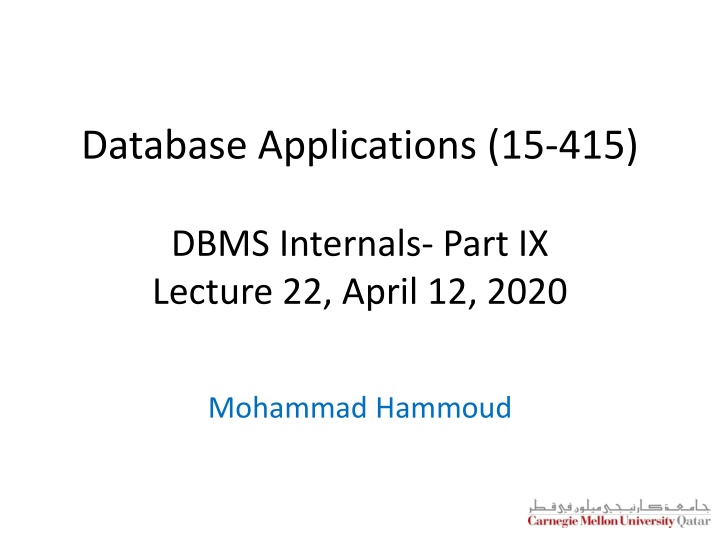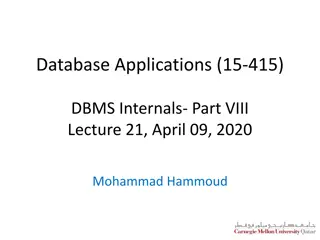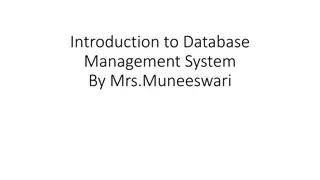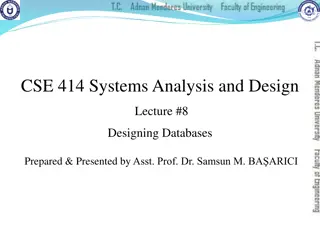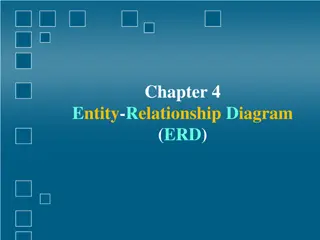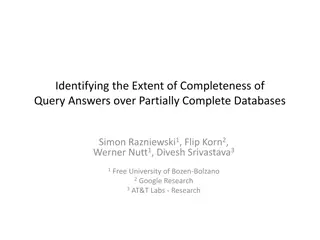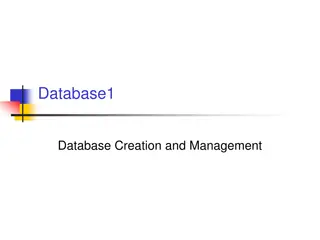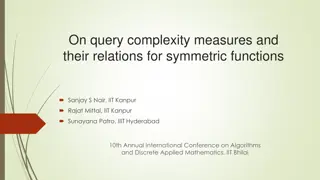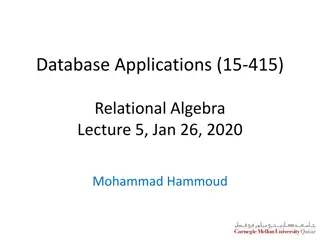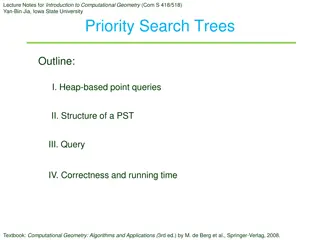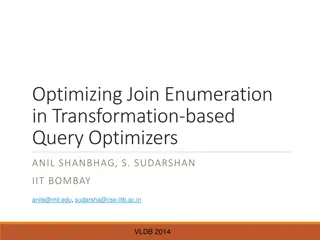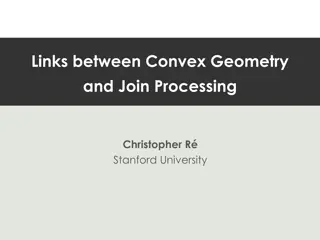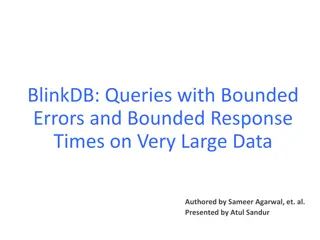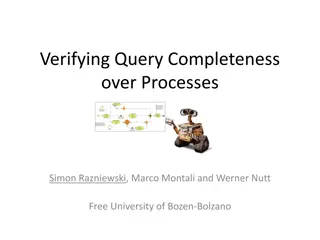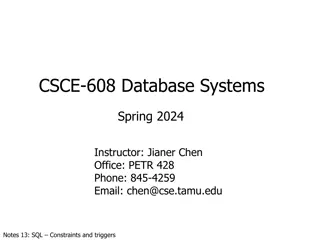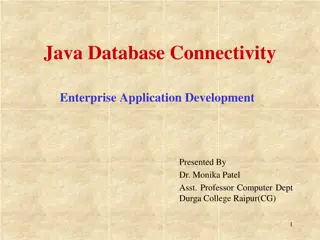Query Optimization in Database Management Systems
This content covers the fundamentals of query optimization in Database Management Systems (DBMS), including steps involved, required information for evaluating queries, cost-based query sub-system, and the role of various components like query parser, optimizer, plan generator, and cost estimator. It emphasizes the significance of transforming queries into efficient query evaluation plans by considering factors such as internal forms, alternative plan enumeration, cost estimation, and plan selection based on estimated costs.
Download Presentation

Please find below an Image/Link to download the presentation.
The content on the website is provided AS IS for your information and personal use only. It may not be sold, licensed, or shared on other websites without obtaining consent from the author.If you encounter any issues during the download, it is possible that the publisher has removed the file from their server.
You are allowed to download the files provided on this website for personal or commercial use, subject to the condition that they are used lawfully. All files are the property of their respective owners.
The content on the website is provided AS IS for your information and personal use only. It may not be sold, licensed, or shared on other websites without obtaining consent from the author.
E N D
Presentation Transcript
Database Applications (15-415) DBMS Internals- Part IX Lecture 22, April 12, 2020 Mohammad Hammoud
Today Last Session: DBMS Internals- Part VIII Algorithms for Relational Operations (Cont d) Today s Session: DBMS Internals- Part IX Query Optimization Announcements: PS4 is due on April 15 P3 is due on April 18
DBMS Layers Queries Query Optimization and Execution Relational Operators Files and Access Methods Transaction Manager Recovery Manager Buffer Management Lock Manager Disk Space Management DB
Outline A Brief Primer on Query Optimization Evaluating Query Plans Relational Algebra Equivalences Estimating Plan Costs Enumerating Plans
Cost-Based Query Sub-System Select * From Blah B Where B.blah = blah Queries Usually there is a heuristics-based rewriting step before the cost-based steps. Query Parser Query Optimizer Plan Generator Plan Cost Estimator Catalog Manager Schema Statistics Query Plan Evaluator
Query Optimization Steps Step 1: Queries are parsed into internal forms (e.g., parse trees) Step 2: Internal forms are transformed into canonical forms (syntactic query optimization) Step 3: A subset of alternative plans are enumerated Step 4: Costs for alternative plans are estimated Step 5: The query evaluation plan with the least estimated cost is picked
Required Information to Evaluate Queries To estimate the costs of query plans, the query optimizer examines the system catalog and retrieves: Information about the types and lengths of fields Statistics about the referenced relations Access paths (indexes) available for relations In particular, the Schema and Statistics components in the Catalog Manager are inspected to find a good enough query evaluation plan
Cost-Based Query Sub-System Select * From Blah B Where B.blah = blah Queries Usually there is a heuristics-based rewriting step before the cost-based steps. Query Parser Query Optimizer Plan Generator Plan Cost Estimator Catalog Manager Schema Statistics Query Plan Evaluator
Catalog Manager: The Schema What kind of information do we store at the Schema? Information about tables (e.g., table names and integrity constraints) and attributes (e.g., attribute names and types) Information about indices (e.g., index structures) Information about users Where do we store such information? In tables, hence, can be queried like any other tables For example: Attribute_Cat (attr_name: string, rel_name: string; type: string; position: integer)
Catalog Manager: Statistics What would you store at the Statistics component? NTuples(R): # records for table R NPages(R): # pages for R NKeys(I): # distinct key values for index I INPages(I): # pages for index I IHeight(I): # levels for I ILow(I), IHigh(I): range of values for I ... Such statistics are important for estimating plan costs and result sizes (to be discussed shortly!)
SQL Blocks SQL queries are optimized by decomposing them into a collection of smaller units, called blocks A block is an SQL query with: No nesting Exactly 1 SELECT and 1 FROM clauses At most 1 WHERE, 1 GROUP BY and 1 HAVING clauses A typical relational query optimizer concentrates on optimizing a single block at a time
Translating SQL Queries Into Relational Algebra Trees select name from STUDENT, TAKES where c-id= 415 and STUDENT.ssn=TAKES.ssn TAKES STUDENT An SQL block can be thought of as an algebra expression containing: A cross-product of all relations in the FROM clause Selections in the WHERE clause Projections in the SELECT clause Remaining operators can be carried out on the result of such SQL block
Translating SQL Queries Into Relational Algebra Trees (Cont d) Canonical form TAKES STUDENT TAKES STUDENT Still the same result! How can this be guaranteed?
Translating SQL Queries Into Relational Algebra Trees (Cont d) Canonical form TAKES STUDENT TAKES STUDENT OBSERVATION: try to perform selections and projections early!
Translating SQL Queries Into Relational Algebra Trees (Cont d) Hash join; merge join; nested loops; Index; seq scan TAKES STUDENT How to evaluate a query plan (as opposed to evaluating an operator)?
Outline A Brief Primer on Query Optimization Evaluating Query Plans Relational Algebra Equivalences Estimating Plan Costs Enumerating Plans
Query Evaluation Plans A query evaluation plan (or simply a plan) consists of an extended relational algebra tree (or simply a tree) A plan tree consists of annotations at each node indicating: The access methods to use for each relation The implementation method to use for each operator Consider the following SQL query Q: SELECT S.sname FROM Reserves R, Sailors S WHERE R.sid=S.sid AND R.bid=100 AND S.rating>5 What is the corresponding RA of Q?
Query Evaluation Plans (Contd) Q can be expressed in relational algebra as follows: ( (Re 5 ) serves Sailors sname 100 = = bid rating sid sid An Extended RA Tree: A RA Tree: (On-the-fly) sname sname (On-the-fly) rating > 5 bid=100 rating > 5 bid=100 (Simple Nested Loops) sid=sid sid=sid Sailors Reserves Sailors Reserves (File Scan) (File Scan)
Pipelining vs. Materializing When a query is composed of several operators, the result of one operator can sometimes be pipelined to another operator Applied on-the-fly (On-the-fly) sname Pipeline the output of the join into the selection and projection that follow (On-the-fly) rating > 5 bid=100 (Simple Nested Loops) sid=sid Sailors Reserves (File Scan) (File Scan)
Pipelining vs. Materializing When a query is composed of several operators, the result of one operator can sometimes be pipelined to another operator Applied on-the-fly (On-the-fly) sname Pipeline the output of the join into the selection and projection that follow (On-the-fly) rating > 5 bid=100 (Simple Nested Loops) In contrast, a temporary table can be materialized to hold the intermediate result of the join and read back by the selection operation! sid=sid Sailors Reserves (File Scan) (File Scan) Pipelining can significantly save I/O cost!
The I/O Cost of the Q Plan What is the I/O cost of the following evaluation plan? (On-the-fly) sname (On-the-fly) rating > 5 bid=100 (Simple Nested Loops) sid=sid Sailors Reserves (File Scan) (File Scan) The cost of the join is 1000 + 1000 * 500 = 501,000 I/Os (assuming page-oriented Simple NL join) The selection and projection are done on-the-fly; hence, do not incur additional I/Os
Pushing Selections How can we reduce the cost of a join? By reducing the sizes of the input relations! sname rating > 5 bid=100 Involves bid in Reserves; hence, push ahead of the join! Involves rating in Sailors; hence, push ahead of the join! sid=sid Sailors Reserves
Pushing Selections How can we reduce the cost of a join? By reducing the sizes of the input relations! sname(On-the-fly) (On-the-fly) sname (Sort-Merge Join) (On-the-fly) rating > 5 bid=100 sid=sid (Scan; write to temp T2) (Scan; write to temp T1) rating > 5 bid=100 (Simple Nested Loops) sid=sid Reserves Sailors Sailors (File Scan) Reserves (File Scan)
The I/O Cost of the NewQ Plan What is the I/O cost of the following evaluation plan? sname(On-the-fly) (Sort-Merge Join) sid=sid (Scan; write to temp T2) (Scan; write to temp T1) rating > 5 bid=100 Reserves Sailors Cost of Scanning Reserves = 1000 I/Os Cost of Writing T1 = 10* I/Os (later) Cost of Scanning Sailors = 500 I/Os Cost of Writing T2 = 250* I/Os (later) *Assuming 100 boats and uniform distribution of reservations across boats. *Assuming 10 ratings and uniform distribution over ratings.
The I/O Cost of the NewQ Plan What is the I/O cost of the following evaluation plan? sname(On-the-fly) Merge Cost = 10 + 250 = 260 I/Os Cost = 2 4 250 = 2000 I/Os (assuming B = 5) Cost = 2 2 10 = 40 I/Os (assuming B = 5) (Sort-Merge Join) sid=sid (Scan; write to temp T2) (Scan; write to temp T1) rating > 5 bid=100 Reserves Sailors
The I/O Cost of the NewQ Plan What is the I/O cost of the following evaluation plan? Done on-the-fly, thus, do not incur additional I/Os sname(On-the-fly) (Sort-Merge Join) sid=sid (Scan; write to temp T2) (Scan; write to temp T1) rating > 5 bid=100 Reserves Sailors
The I/O Cost of the NewQ Plan What is the I/O cost of the following evaluation plan? Done on-the-fly, thus, do not incur additional I/Os sname(On-the-fly) Merge Cost = 10 + 250 = 260 I/Os Cost = 2 4 250 = 2000 I/Os (assuming B = 5) Cost = 2 2 10 = 40 I/Os (assuming B = 5) (Sort-Merge Join) sid=sid (Scan; write to temp T2) (Scan; write to temp T1) rating > 5 bid=100 Reserves Sailors Cost of Scanning Reserves = 1000 I/Os Cost of Writing T1 = 10 I/Os (later) Cost of Scanning Sailors = 500 I/Os Cost of Writing T2 = 250 I/Os (later) Total Cost = 1000 + 10 + 500 + 250 + 40 + 2000 + 260 = 4060 I/Os
The I/O Costs of the TwoQ Plans sname(On-the-fly) (On-the-fly) sname (Sort-Merge Join) (On-the-fly) rating > 5 sid=sid bid=100 (Scan; write to temp T2) (Scan; write to temp T1) rating > 5 bid=100 (Simple Nested Loops) sid=sid Reserves Sailors Sailors (File Scan) Reserves (File Scan) Total Cost = 4060 I/Os Total Cost = 501, 000 I/Os
Pushing Projections How can we reduce the cost of a join? By reducing the sizes of the input relations! Consider (again) the following plan: What are the attributes required from T1 and T2? Sid from T1 Sid and sname from T2 sname sid=sid Hence, as we scan Reserves and Sailors we can also remove unwanted columns (i.e., Push the projections ahead of the join)! (Scan; write to temp T2) (Scan; write to temp T1) rating > 5 bid=100 Reserves Sailors
Pushing Projections How can we reduce the cost of a join? By reducing the sizes of the input relations! Consider (again) the following plan: sname Push ahead the join The cost after applying this heuristic can become 2000 I/Os (as opposed to 4060 I/Os with only pushing the selection)! sid=sid (Scan; write to temp T2) (Scan; write to temp T1) rating > 5 bid=100 Reserves Sailors
Using Indexes What if indexes are available on Reserves and Sailors? (On-the-fly) sname (On-the-fly) rating > 5 (Index Nested Loops, with pipelining ) sid=sid (Use hash index; do not write result to temp) Sailors (Hash index on sid) bid=100 (Clustered hash index on bid) Reserves With clustered index on bid of Reserves, we get 100,000/100 = 1000 tuples (assuming 100 boats and uniform distribution of reservations across boats) Since the index is clustered, the 1000 tuples appear consecutively within the same bucket; thus # of pages = 1000/100 = 10 pages
Using Indexes What if indexes are available on Reserves and Sailors? (On-the-fly) sname (On-the-fly) rating > 5 (Index Nested Loops, with pipelining ) sid=sid (Use hash index; do not write result to temp) Sailors (Hash index on sid) bid=100 (Clustered hash index on bid) Reserves For each selected Reserves tuple, we can retrieve matching Sailors tuples using the hash index on the sid field Selected Reserves tuples need not be materialized and the join result can be pipelined! For each tuple in the join result, we apply rating > 5 and the projection of sname on-the-fly
Using Indexes What if indexes are available on Reserves and Sailors? (On-the-fly) sname Is it necessary to project out unwanted columns? (On-the-fly) rating > 5 NO, since selection results are NOT materialized (Index Nested Loops, with pipelining ) sid=sid (Use hash index; do not write result to temp) Sailors (Hash index on sid) bid=100 (Clustered hash index on bid) Reserves
Using Indexes What if indexes are available on Reserves and Sailors? (On-the-fly) sname Does the hash index on sid need to be clustered? (On-the-fly) rating > 5 NO, since there is at most 1 matching Sailors tuple per a Reserves tuple! Why? (Index Nested Loops, with pipelining ) sid=sid (Use hash index; do not write result to temp) Sailors (Hash index on sid) bid=100 (Clustered hash index on bid) Reserves
Using Indexes What if indexes are available on Reserves and Sailors? (On-the-fly) sname (On-the-fly) rating > 5 (Index Nested Loops, with pipelining ) sid=sid Cost = 1.2 I/Os (if A(1)) or 2.2 (if A(2)) (Use hash index; do not write result to temp) Sailors (Hash index on sid) bid=100 (Clustered hash index on bid) Reserves
Using Indexes What if indexes are available on Reserves and Sailors? (On-the-fly) sname Why not pushing this selection ahead of the join? (On-the-fly) rating > 5 It would require a scan on Sailors! (Index Nested Loops, with pipelining ) sid=sid (Use hash index; do not write result to temp) Sailors (Hash index on sid) bid=100 (Clustered hash index on bid) Reserves
The I/O Cost of the NewQ Plan What is the I/O cost of the following evaluation plan? (On-the-fly) sname (On-the-fly) rating > 5 (Index Nested Loops, with pipelining ) 10 I/Os sid=sid (Use hash index; do not write result to temp) Cost = 1.2 I/Os for 1000 Reserves tuples; hence, 1200 I/Os Sailors (Hash index on sid) bid=100 (Clustered hash index on bid) Reserves Total Cost = 10 + 1200 = 1210 I/Os
Comparing I/O Costs: Recap (On-the-fly) (On-the-fly) (On-the-fly) sname sname sname (On-the-fly) rating > 5 (On-the-fly) (Sort-Merge Join) bid=100 rating > 5 sid=sid (Index Nested Loops, with pipelining ) (Scan; write to temp T1) (Scan; write to temp T2) sid=sid rating > 5 bid=100 (Simple Nested Loops) (Hash index) sid=sid (Hash index on sid) Sailors bid=100 Reserves Sailors Sailors (File Scan) Reserves (File Scan) Reserves Total Cost = 501, 000 I/Os Total Cost = 4060 I/Os Total Cost = 1210 I/Os
But, How Can we Ensure Correctness? sname sname Canonical form rating > 5 rating > 5 bid=100 sid=sid sid=sid Sailors bid=100 Sailors Reserves Reserves Still the same result! How can this be guaranteed?
Outline A Brief Primer on Query Optimization Evaluating Query Plans Relational Algebra Equivalences Estimating Plan Costs Enumerating Plans
Relational Algebra Equivalences A relational query optimizer uses relational algebra equivalences to identify many equivalent expressions for a given query Two relational algebra expressions over the same set of input relations are said to be equivalent if they produce the same result on all relations instances Relational algebra equivalences allow us to: Push selections and projections ahead of joins Combine selections and cross-products into joins Choose different join orders
RA Equivalences: Selections Two important equivalences involve selections: 1. Cascading of Selections: ( ) ( ) R ( ) R ... ... 1 1 c cn c cn Allows us to combine several selections into one selection OR: Allows us to replace a selection with several smaller selections 2. Commutation of Selections: ( c 1 ) ( ) ( ) R ( ) R 2 2 1 c c c Allows us to test selection conditions in either order
RA Equivalences: Projections One important equivalence involves projections: Cascading of Projections: ( ) R ( ( ( ) R ) ) ... 1 1 a a an This says that successively eliminating columns from a relation is equivalent to simply eliminating all but the columns retained by the final projection!
RA Equivalences: Cross-Products and Joins Two important equivalences involve cross-products and joins: 1. Commutative Operations: (R S) (S R) (R S) (S R) This allows us to choose which relation to be the inner and which to be the outer!
RA Equivalences: Cross-Products and Joins Two important equivalences involve cross-products and joins: 2. Associative Operations: R (S T) (R S) T R (S T) (R S) T R (S T) (T R) S It follows: This says that regardless of the order in which the relations are considered, the final result is the same! This order-independence is fundamental to how a query optimizer generates alternative query evaluation plans
RA Equivalences: Selections, Projections, Cross Products and Joins Selections with Projections: ( ( )) ( ( )) R R a c c a This says we can commute a selection with a projection if the selection involves only attributes retained by the projection! Selections with Cross-Products: R T ( ) R S c c This says we can combine a selection with a cross-product to form a join (as per the definition of a join)!
RA Equivalences: Selections, Projections, Cross Products and Joins Selections with Cross-Products and with Joins: S R c ) ( S R c ) ( ( ) R S c ( ) R S c Caveat: The attributes mentioned in c must appear only in R and NOT in S This says we can commute a selection with a cross-product or a join if the selection condition involves only attributes of one of the arguments to the cross-product or join!
RA Equivalences: Selections, Projections, Cross Products and Joins Selections with Cross-Products and with Joins (Cont d): ) ( c c c ( 1 c c ( 1 c c ( ) R S R S ( 1 2 3 c ( ))) R S 2 3 c ) ( ( )) R S 2 3 c This says we can push part of the selection condition c ahead of the cross-product! This applies to joins as well!
RA Equivalences: Selections, Projections, Cross Products and Joins Projections with Cross-Products and with Joins: ( 1 a a ) ( a c a ( ) ) ( ) R S R S 2 a ( ) ( ) R S R S c 1 2 a ( ) ( ( ) ( )) R S R S a c a c 1 2 a a Intuitively, we need to retain only those attributes of R and S that are either mentioned in the join condition c or included in the set of attributes a retained by the projection
How to Estimate the Cost of Plans? Now that correctness is ensured, how can the DBMS estimate the costs of various plans? sname sname Canonical form rating > 5 rating > 5 bid=100 sid=sid sid=sid Sailors bid=100 Sailors Reserves Reserves
